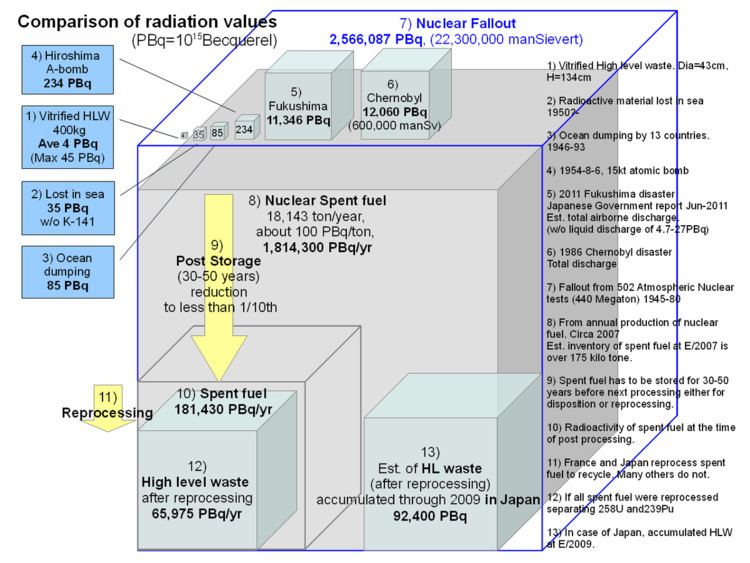 | ||
From 1946 through 1993, thirteen countries (fourteen, if the USSR and Russia are considered separately) used ocean disposal or ocean dumping as a method to dispose of nuclear/radioactive waste. The waste materials included both liquids and solids housed in various containers, as well as reactor vessels, with and without spent or damaged nuclear fuel. Since 1993, ocean disposal has been banned by international treaties. (London Convention (1972), Basel Convention, MARPOL 73/78)
Contents
- History
- 194693
- Types of waste and packaging
- Liquid waste
- Solid waste
- Reactor vessels
- Dump sites
- Arctic
- North Atlantic
- Pacific Ocean
- East Sea
- Environmental impact
- Arctic Ocean
- North East Atlantic Ocean
- North East Pacific Ocean North West Atlantic Ocean dump sites of USA
- North West Pacific Ocean dump sites of USSR Japan Russia and Korea
- References
However, according to the United Nations, some companies have been dumping radioactive waste and other hazardous materials into the coastal waters of Somalia, taking advantage of the fact that the country had no functioning government from the early 1990s onwards. According to one official at the United Nations, this caused health problems for locals in the coastal region and posed a significant danger to Somalia's fishing industry and local marine life.
"Ocean floor disposal" (or sub-seabed disposal)—a more deliberate method of delivering radioactive waste to the ocean floor and depositing it into the seabed—was studied by the UK and Sweden, but never implemented.
History
Data are from IAEA-TECDOC-1105. page 3-4
1946–93
Data are from IAEA-TECDOC-1105. Summary of pages 27–120
Disposal projects attempted to locate ideal dumping sites based on depth, stability and currents, and to treat, solidify and contain the waste. However, some dumping only involved diluting the waste with surface water, or used containers that imploded at depth. Even containers that survived the pressure could physically decay over time.
The countries involved — listed in order of total contributions measured in TBq (TBq=1012 Becquerel) — were the USSR, the UK, Switzerland, the US, Belgium, France, the Netherlands, Japan, Sweden, Russia, New Zealand, Germany, Italy and South Korea. Together, they dumped a total of 85,100 TBq (85.1x1015Bq) of radioactive waste at over 100 ocean sites, as measured in initial radioactivity at the time of dump.
For comparison:
Types of waste and packaging
Data are from IAEA-TECDOC-1105.
Liquid waste
Solid waste
Reactor vessels
Dump sites
Data are from IAEA-TECDOC-1105.
Arctic
Mainly at the east coast of Novaya Zemlya at Kara Sea and relatively small proportion at Barentz Sea by USSR. Dumped at 20 sites from 1959–92, total of 222x103m3 including reactors and spent fuel.
North Atlantic
Dumping occurred from 1948 to 1982. 78% of dumping in the Atlantic was done by UK (35,088TBq), followed by Switzerland (4,419TBq), USA (2,924TBq) and Belgium (2,120TBq). Sunken USSR nuclear submarines are not included. see List of sunken nuclear submarines
137x103tonnes were dumped by 8 European countries. USA reported neither tonnage nor volume for 34,282 containers.
Pacific Ocean
USSR 874TBq, USA 554 TBq, Japan 15.1TBq, New Zealand 1+TBq and unknown amount by South Korea. 751x103m3 were dumped by Japan and USSR. USA reported neither tonnage nor volume of 56,261 containers.
Dumping of contaminated water at 2011 Fukushima Nuclear accident (estimate 4,700–270,00TBq) is not included.
East Sea
USSR dumped 749TBq in the Sea of Japan, Japan dumped 15.1TBq south of main island. South Korea dumped 45 tonnes (unknown radioactivity value) in the Sea of Japan.
Environmental impact
Data are from IAEA-TECDOC-1105.
Arctic Ocean
Joint Russian-Norwegian expeditions (1992–94) collected samples from four dump sites. At immediate vicinity of waste containers, elevated levels of radionuclide were found, but had not contaminated the surrounding area.
North-East Atlantic Ocean
Dumping was undertaken by UK, Switzerland, Belgium, France, the Netherlands, Sweden, Germany and Italy. IAEA had been studying since 1977. In the report of 1996 by CRESP suggests measurable leakages of radioactive material but concluded that environmental impact is negligible.
North-East Pacific Ocean, North-West Atlantic Ocean dump sites of USA
These sites are monitored by the United States Environmental Protection Agency and US National Oceanic and Atmospheric Administration. So far, no excess level of radionuclides was found in samples (sea water, sediments) collected in the area, except the sample taken at a location close to disposed packages that contained elevated levels of isotopes of caesium and plutonium.
North-West Pacific Ocean dump sites of USSR, Japan, Russia and Korea
The joint Japanese-Korean-Russian expedition (1994–95) concluded that contamination resulted mainly from global fallout.
